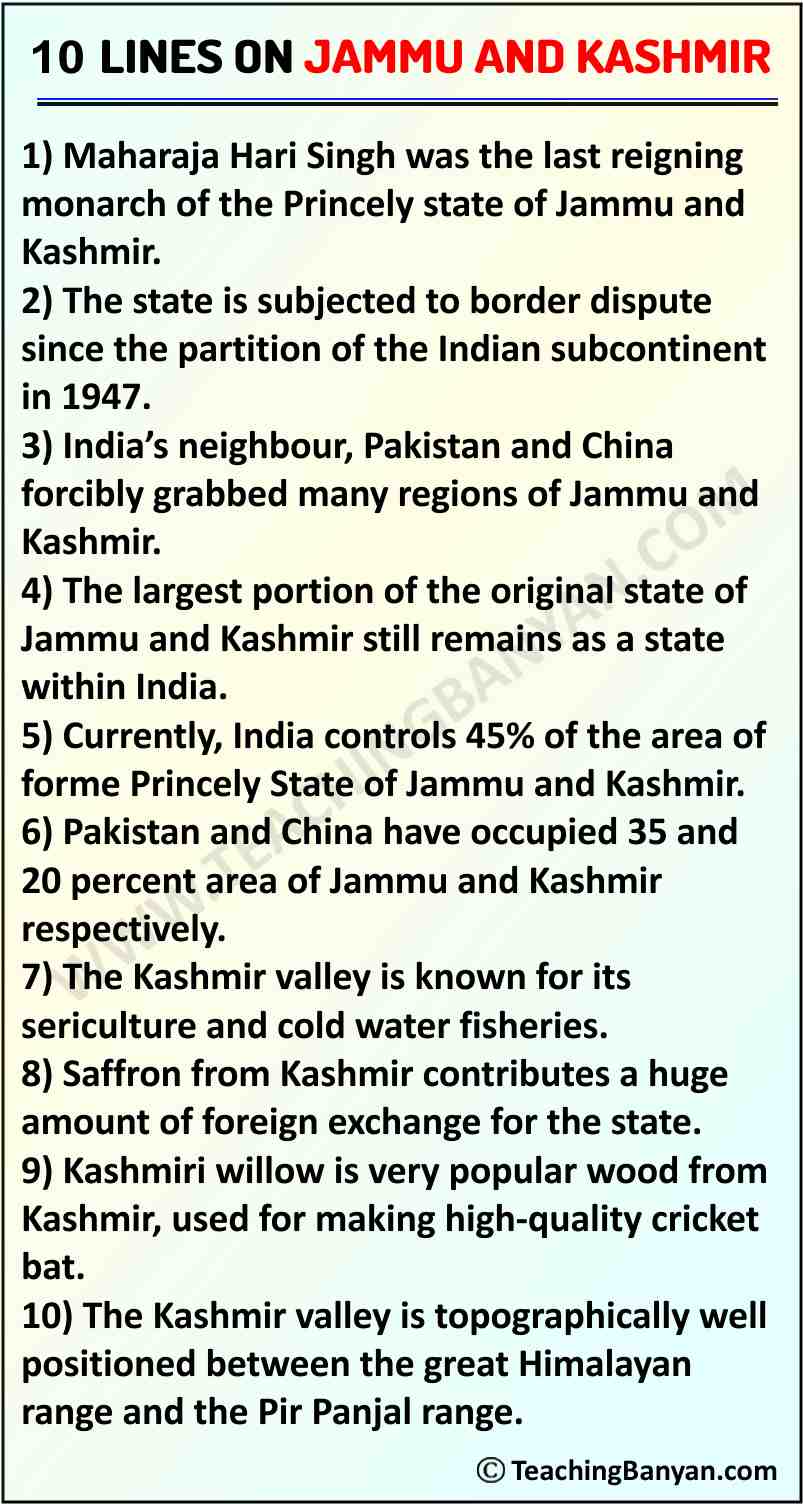The state of Jammu and Kashmir is situated on the highest latitude on the map of India, like a jewel in the crown. The scenic topography and pleasant weather of the state have attracted tourist from all over the world. Tourism from travel enthusiasts and pilgrims vastly contribute to the state’s economy. The tension in the region due to the border dispute between India, Pakistan and China has negatively affected life in the state. India has fought five wars with neighbouring countries over the state of Jammu and Kashmir since its Independence.
Ten Lines on Jammu and Kashmir
Set 1
1) Jammu and Kashmir are a Union Territory in India.
2) It has two capitals; Jammu and Sri Nagar.
3) For its natural beauty, it is called heaven on earth.
4) Kashmiri, Dogri and Urdu are the main languages of Jammu and Kashmir.
5) Jammu and Kashmir are mainly divided into three parts; Jammu, Kashmir and Ladakh.
6) The “Pashmina Shawl” of Kashmir is famous in the whole World.
7) Jammu and Kashmir have the majority of the Muslim population.
8) The Ladakh part of Jammu and Kashmir has the majority of Buddhists.
9) The people of Jammu and Kashmir mainly depend on farming and agriculture.
10) It is a tourism spot for people from all around the world.
We are providing another set of ten lines on Jammu and Kashmir in English for class 6, class 7, class 8, class 9 and class 10. After reading these you will know; summer and winter capital of the state, the official language of the state, the flag of Jammu and Kashmir, major rivers flowing through the state and various regions of the state.
Add these few lines in your essays and paragraph writing as well as in your examination and school competitions. It will support your essay on Jammu and Kashmir and current affairs; will serve as background information while writing an essay on the current ongoing situation in Jammu and Kashmir.
Set 2
1) Jammu and Kashmir is the northernmost state of India.
2) The state is named after its two most popular regions in the state: Jammu region and Kashmir region.
3) The other distinct region of the state includes Gilgit, Baltistan and Skardu.
4) Jammu is the winter capital of the state, whereas Srinagar is summer capital.
5) Urdu written in Persian script is the official language of Jammu and Kashmir.
6) Jammu and Kashmir was the only state in India with its own official state flag and constitution.
7) The flag of Jammu and Kashmir featured a white plough and three white vertical stripes on a red background.
8) The red colour represents labour, the plough symbolizes farmers and each stripe represents three distinct administrative divisions of the state.
9) The Jhelum, Indus, Tawi, Ravi and Chenab are the major rivers flowing through the state.
10) The Jhelum is the only major Himalayan river flowing through the valley of Kashmir.
Set 3
1) Maharaja Hari Singh was the last reigning monarch of the Princely state of Jammu and Kashmir.
2) The state is subjected to border dispute since the partition of the Indian subcontinent in 1947.
3) India’s neighbour, Pakistan and China forcibly grabbed many regions of Jammu and Kashmir.
4) The largest portion of the original state of Jammu and Kashmir still remains as a state within India.
5) Currently, India controls 45% of the area of former Princely State of Jammu and Kashmir.
6) Pakistan and China have occupied 35 and 20 per cent area of Jammu and Kashmir respectively.
7) The Kashmir valley is known for its sericulture and cold water fisheries.
8) Saffron from Kashmir contributes a huge amount of foreign exchange for the state.
9) Kashmiri willow is very popular wood from Kashmir, used for making high-quality cricket bat.
10) The Kashmir valley is topographically well positioned between the great Himalayan range and the Pir Panjal range.

Set 4
1) Jammu and Kashmir is the only state in India with the majority of Muslim population apart from Union territory Lakshadweep.
2) As per 2011 Census of India, The State of Jammu and Kashmir consists of 68.3% Islamic, 28.4% Hindu, 1.9% Sikhs, 0.9% Buddhists and 0.3% Christian population.
3) The state of Jammu and Kashmir has a very distinctive Physiographic feature.
4) The plains, the Himalayas, the plateau of Ladakh, the Shivaliks and the Kashmir valleys are some major physiographic features of the state.
5) The state of Jammu and Kashmir enjoyed special status for seven decades, due to autonomy granted to the state under Article 370 of the Constitution of India.
6) On 5th August 2019, the Government of India repealed the special status awarded to Jammu and Kashmir.
7) The Parliament of India also passed the Jammu and Kashmir reorganisation act.
8) This reorganizes the state of Jammu and Kashmir into two Union Territories.
9) First one is Jammu and Kashmir with its own legislature and second is Ladakh without legislature.
10) The Reorganization Act will come into effect on 31st October 2019.
We know Jammu and Kashmir has been in a state of turmoil since independence, all wars and militant activities have only negatively impacted the life in the state. Tourism has taken a huge hit due to instability in the region, the British government still advises their citizen to not travel to Jammu and Kashmir except for the cities of Jammu and Srinagar and Ladakh; whereas Canada excludes entire state except Leh. The state of Jammu and Kashmir has had a rich history; recent development in law may put an end to the instability in the region.
